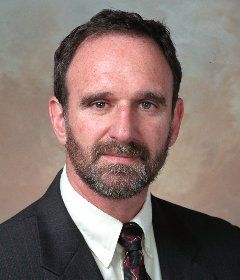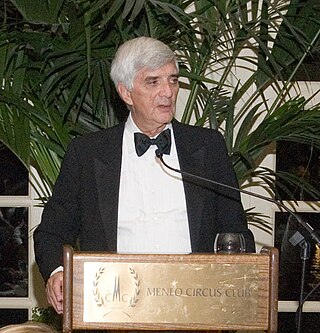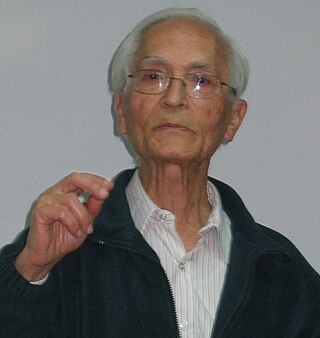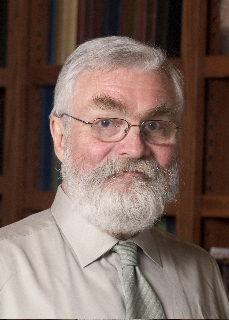Related Research Articles

Martin Edward Hellman is an American cryptologist and mathematician, best known for his invention of public-key cryptography in cooperation with Whitfield Diffie and Ralph Merkle. Hellman is a longtime contributor to the computer privacy debate, and has applied risk analysis to a potential failure of nuclear deterrence.
Trellis coded modulation (TCM) is a modulation scheme that transmits information with high efficiency over band-limited channels such as telephone lines. Gottfried Ungerboeck invented trellis modulation while working for IBM in the 1970s, and first described it in a conference paper in 1976. It went largely unnoticed, however, until he published a new, detailed exposition in 1982 that achieved sudden and widespread recognition.

Robert Gray Gallager is an American electrical engineer known for his work on information theory and communications networks.

Robert Wendell Lucky was an American electrical engineer, inventor, and research manager at Bell Labs and Bell Communications Research (Bellcore). He is best known for his writings and speeches about technology, society, and engineering culture. Bob is a Fellow of the IEEE and a member of the National Academy of Engineering. He is also a member of TTI/Vanguard's advisory board.

Kornelis Antonie "Kees" Schouhamer Immink is a Dutch engineer, inventor, and entrepreneur, who pioneered and advanced the era of digital audio, video, and data recording, including popular digital media such as compact disc (CD), DVD and Blu-ray disc. He has been a prolific and influential engineer, who holds more than 1100 U.S. and international patents. A large portion of the commonly used audio and video playback and recording devices use technologies based on his work. His contributions to coding systems assisted the digital video and audio revolution, by enabling reliable data storage at information densities previously unattainable.

Abraham Lempel was an Israeli computer scientist and one of the fathers of the LZ family of lossless data compression algorithms.
Peter Elias was a pioneer in the field of information theory. Born in New Brunswick, New Jersey, he was a member of the Massachusetts Institute of Technology faculty from 1953 to 1991. In 1955, Elias introduced convolutional codes as an alternative to block codes. He also established the binary erasure channel and proposed list decoding of error-correcting codes as an alternative to unique decoding.

Jacob Ziv was an Israeli electrical engineer and information theorist who developed the LZ family of lossless data compression algorithms alongside Abraham Lempel.
Irving Stoy Reed was an American mathematician and engineer. He is best known for co-inventing a class of algebraic error-correcting and error-detecting codes known as Reed–Solomon codes in collaboration with Gustave Solomon. He also co-invented the Reed–Muller code.
George David Forney Jr. is an American electrical engineer who made contributions in telecommunication system theory, specifically in coding theory and information theory.
Hamid Jafarkhani is an Iranian-born American electrical engineer and professor. He serves as the Chancellor's Professor in electrical engineering and computer science in the Henry Samueli School of Engineering at the University of California, Irvine. His research focuses on communications theory, particularly coding and wireless communications and networks.
Richard E. Blahut, former chair of the Electrical and Computer Engineering Department at the University of Illinois at Urbana–Champaign, is best known for his work in information theory. He received his PhD Electrical Engineering from Cornell University in 1972.

Norman Manuel Abramson was an American engineer and computer scientist, most known for developing the ALOHAnet system for wireless computer communication.
Sergio Verdú is a former professor of electrical engineering and specialist in information theory. Until September 22, 2018, he was the Eugene Higgins Professor of Electrical Engineering at Princeton University, where he taught and conducted research on information theory in the Information Sciences and Systems Group. He was also affiliated with the program in Applied and Computational Mathematics. He was dismissed from the faculty following a university investigation of alleged sexual misconduct.
Marvin Kenneth Simon was a telecommunication engineer who worked extensively for 35 years in the area of modulation, coding, and synchronization for space, satellite, radio, and military communications and also performance evaluation of wireless telecommunication systems over fading channels. Simon got his PhD from New York University in 1966, and worked at the Jet Propulsion Laboratory for the past few decades of his life. The fruits of his research have been successfully applied to the design of many of NASA's deep space and near-earth missions for which he has been earned 11 patents, 25 NASA Tech Briefs, 4 Space Act awards, and over 200 technical papers. He died of brain cancer in September 2007.
Jorma Johannes Rissanen was an information theorist, known for originating the minimum description length (MDL) principle and practical approaches to arithmetic coding for lossless data compression. His work inspired the development of the theory of stochastic chains with memory of variable length.
Jack Keil Wolf was an American researcher in information theory and coding theory.

Robert M. Gray is an American information theorist, and the Alcatel-Lucent Professor of Electrical Engineering at Stanford University in Palo Alto, California. He is best known for his contributions to quantization and compression, particularly the development of vector quantization.

John Mathew Cioffi is an American electrical engineer, educator and inventor who has made contributions in telecommunication system theory, specifically in coding theory and information theory. Best known as "the father of DSL," Cioffi's pioneering research was instrumental in making digital subscriber line (DSL) technology practical and has led to over 400 publications and more than 100 pending or issued patents, many of which are licensed.
Professor Shlomo Shamai (Shitz) (Hebrew: שלמה שמאי (שיץ) ) is a distinguished professor at the Department of Electrical engineering at the Technion − Israel Institute of Technology. Professor Shamai is an information theorist and winner of the 2011 Shannon Award.
References
- ↑ "IEEE Fellows 1985 | IEEE Communications Society".
- ↑ "IEEE Richard W. Hamming Medal Recipients" (PDF). IEEE . Retrieved May 29, 2011.
- ↑ "Golden Jubilee Awards for Technological Innovation". IEEE Information Theory Society . Retrieved July 14, 2011.